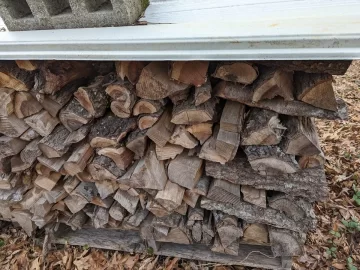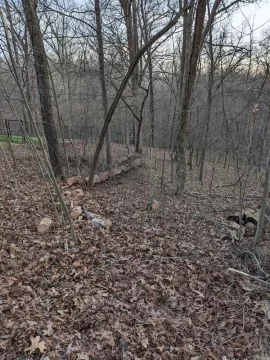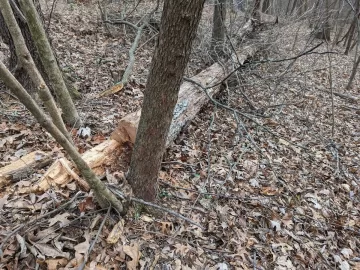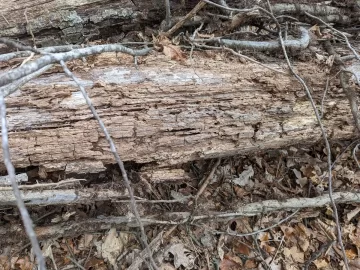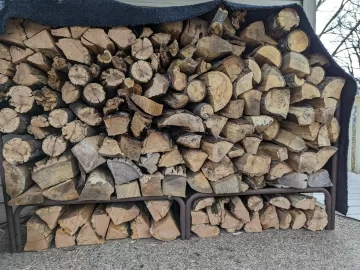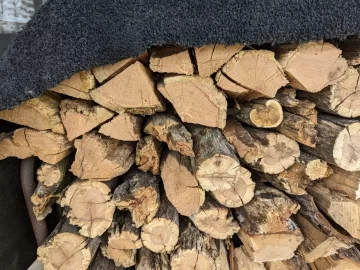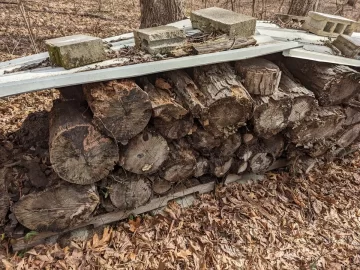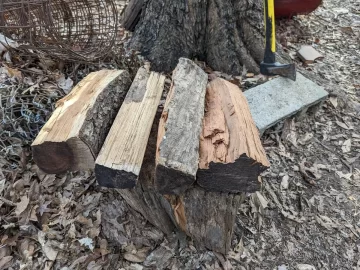I lit a fire last night, and it took a while to get the cold stove rolling. When the top front split didn't seem to be catching and flaming in a top-down start, I opened the load door to have a look, and saw some moisture hissing out the end of the Black Cherry split. This wood sat in rounds for three years, rotted sapwood could be easily brushed or scraped off, some was moist, and I split it last fall, not real big. I jabbed a few with the moisture as I was splitting, and don't recall any readings that were much over 20%. Now, I read here a lot that Cherry "dries fast," so I thought for sure that everything would be down to at least 18% by the time I started burning it.
The split that was hissing last night was selected because it was not real big and I figured that would be dry for sure. It was showing moisture along the edges where it was starting to burn, which makes sense. Then it stopped hissing or showing moisture after the moisture you see in the pic was gone. This load was mostly Cherry, and none of the other splits showed any moisture or did any hissing.
I seem to recall that other Cherry in the past has hissed a bit, even after being split a couple years, so I thought at the time that maybe Cherry has a tendency to absorb water from rain that blows into the side of the stack. Not sure if that would happen more on Cherry than other species--maybe that would have to do with the wood structure of Cherry...?
I've also been burning some hard Maple that sat in rounds for two summers, at least, and was split toward the beginning of summer. I also have some BL where the rounds sat for maybe five years, and was also split last fall. That might be one of those, the small split in front, under the Cherry. It appears to show a small moist spot as well. Another thin one is behind the Cherry.
Once I got the load going, the burn progressed well, and high temps were attained. I thought that if wood was wet, you would see the effects further along in the load, maybe lower temps or less flaming in the box...that is doesn't get expelled from the centers of all the splits in the load.
My window has gotten a bit gunky a few times, so I've wondered whether the Maple or Cherry maybe were not quite fully dry.
The pics are in chronological order, first pic was earlier in rhe burn, second was later and as you see, wetness was subsiding. Has anyone seen examples of this seemingly residual/reabsorbed moisture that you figured should've been gone?
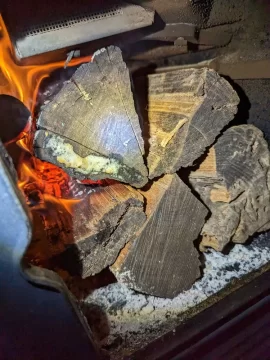
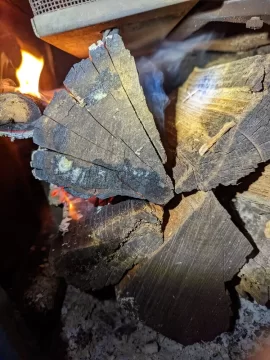
The split that was hissing last night was selected because it was not real big and I figured that would be dry for sure. It was showing moisture along the edges where it was starting to burn, which makes sense. Then it stopped hissing or showing moisture after the moisture you see in the pic was gone. This load was mostly Cherry, and none of the other splits showed any moisture or did any hissing.
I seem to recall that other Cherry in the past has hissed a bit, even after being split a couple years, so I thought at the time that maybe Cherry has a tendency to absorb water from rain that blows into the side of the stack. Not sure if that would happen more on Cherry than other species--maybe that would have to do with the wood structure of Cherry...?
I've also been burning some hard Maple that sat in rounds for two summers, at least, and was split toward the beginning of summer. I also have some BL where the rounds sat for maybe five years, and was also split last fall. That might be one of those, the small split in front, under the Cherry. It appears to show a small moist spot as well. Another thin one is behind the Cherry.
Once I got the load going, the burn progressed well, and high temps were attained. I thought that if wood was wet, you would see the effects further along in the load, maybe lower temps or less flaming in the box...that is doesn't get expelled from the centers of all the splits in the load.
My window has gotten a bit gunky a few times, so I've wondered whether the Maple or Cherry maybe were not quite fully dry.
The pics are in chronological order, first pic was earlier in rhe burn, second was later and as you see, wetness was subsiding. Has anyone seen examples of this seemingly residual/reabsorbed moisture that you figured should've been gone?


Last edited:


